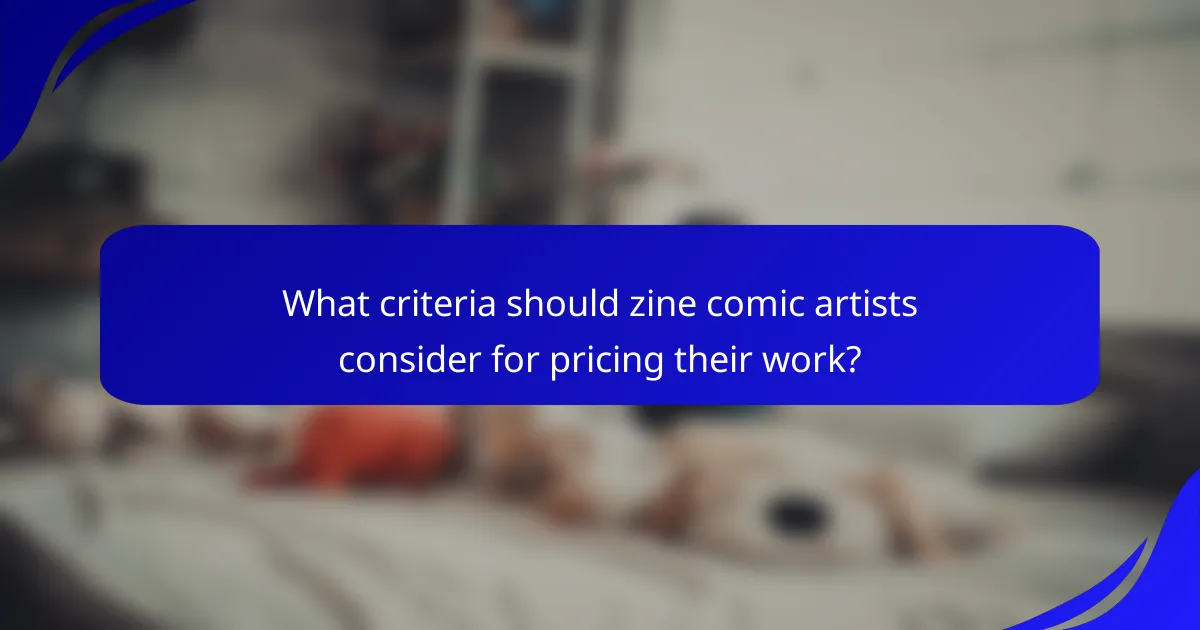Zine comic artists face varying material costs influenced by printing methods, paper quality, and distribution choices, making it essential to budget effectively for sustainability. By leveraging online platforms, local shops, and events, these artists can maximize their reach and connect with diverse audiences, from local communities to global niche markets. Despite the potential for a loyal readership, zine comics often cater to a dedicated but sometimes limited audience, emphasizing the importance of awareness and engagement in their distribution strategies.

What are the material costs for zine comic artists in the US?
The material costs for zine comic artists in the US can vary significantly based on factors like printing methods, paper quality, and distribution choices. Understanding these costs is crucial for budgeting and ensuring the sustainability of a zine project.
Printing costs for zines
Printing costs can range from a few cents to several dollars per copy, depending on the printing method and volume. Digital printing is often more affordable for smaller runs, while offset printing may be more cost-effective for larger quantities. Artists should compare quotes from local print shops and online services to find the best deal.
Consideration of print quality is also essential; higher-quality prints may come at a premium but can enhance the overall appeal of the zine. Look for deals or discounts, especially when ordering in bulk.
Paper quality and pricing
Paper quality significantly impacts both the cost and the final look of a zine. Standard paper types include uncoated, glossy, and recycled options, with prices typically ranging from $0.05 to $0.20 per sheet. Choosing a thicker paper can add to the durability but will increase costs.
Artists should balance quality and budget by sampling different paper types before making a final decision. Many local print shops offer swatches or samples to help in selecting the right paper for the project.
Distribution expenses
Distribution expenses can include shipping costs, fees for online platforms, and costs associated with selling at events. Shipping within the US can range from $3 to $10 per package, depending on size and weight. Artists should factor these costs into their pricing strategy to maintain profitability.
Utilizing local events or consignment arrangements with local shops can help reduce shipping costs and increase visibility. Consider using social media to promote direct sales, which can minimize distribution expenses.
Artwork and design costs
Artwork and design costs can vary widely based on whether the artist is creating their own content or hiring freelancers. Commissioning artwork from other artists can range from $50 to several hundred dollars per piece, depending on the artist’s experience and the complexity of the work.
For those on a tight budget, using DIY design tools or templates can significantly reduce costs. Investing time in learning basic design skills can also yield professional-looking results without the added expense.
Marketing budget considerations
Marketing budgets for zine comic artists should account for online advertising, promotional materials, and event participation. A modest marketing budget might range from $50 to $200, depending on the strategies employed. Social media platforms offer cost-effective ways to promote zines without large financial commitments.
Artists should prioritize building an online presence and engaging with their audience through regular updates and promotions. Collaborating with other artists or participating in zine fairs can also enhance visibility without significant costs.

How can zine comic artists distribute their work effectively?
Zine comic artists can distribute their work effectively through a combination of online platforms, local shops, events, and collaborations. Each method has unique advantages that can help reach different audiences and maximize visibility.
Online platforms for distribution
Online platforms provide a broad reach for zine comic artists, allowing them to sell and share their work globally. Websites like Etsy, Gumroad, and personal blogs can serve as storefronts, while social media channels like Instagram and Twitter help promote their comics to diverse audiences.
When using online platforms, artists should consider the fees associated with each service and how they affect pricing. It’s beneficial to engage with followers regularly to build a community and encourage purchases.
Local comic shops and bookstores
Local comic shops and bookstores are vital venues for zine comic distribution, especially for artists looking to connect with their community. Many shops welcome local creators and may offer consignment deals, allowing artists to showcase their work without upfront costs.
Artists should approach shops with a professional pitch, including a sample of their zine and information about their audience. Building relationships with shop owners can lead to events like signings or readings, further increasing visibility.
Art fairs and conventions
Art fairs and conventions provide excellent opportunities for zine comic artists to reach a concentrated audience. These events often attract fans specifically interested in comics, making them ideal for direct sales and networking.
Participation in these events typically requires booth fees, which can vary widely. Artists should prepare by creating an engaging display and having promotional materials ready, such as business cards or flyers, to capture potential customers’ interest.
Collaborations with other artists
Collaborating with other artists can expand a zine comic artist’s reach and introduce their work to new audiences. Joint projects, such as anthologies or shared events, can leverage each artist’s network for greater exposure.
When collaborating, it’s essential to establish clear agreements regarding contributions and profits. This ensures that all parties are aligned and can focus on creating quality work that resonates with a broader audience.

What is the audience reach for zine comics?
The audience reach for zine comics can vary widely, typically ranging from local communities to global niche markets. Zine comics often attract dedicated readers who appreciate independent art and storytelling, leading to a loyal but sometimes limited audience base.
Demographics of zine readers
Zine readers often skew towards younger audiences, particularly those aged 18 to 30, who are drawn to alternative and independent media. Many readers are students, artists, or individuals involved in subcultures that value DIY ethics and self-expression.
While zine readership can be diverse, it often includes a significant representation of marginalized groups. This demographic engagement can enhance community building and foster a sense of belonging among readers.
Engagement through social media
Social media platforms play a crucial role in expanding the audience reach for zine comics. Artists can share their work, connect with readers, and promote events through platforms like Instagram, Twitter, and TikTok, where visual content thrives.
Utilizing hashtags relevant to zines and comics can significantly increase visibility. Engaging with followers through polls, Q&A sessions, and behind-the-scenes content can also strengthen the relationship between creators and their audience.
Impact of niche communities
Niche communities greatly influence the audience reach of zine comics by creating spaces for targeted discussions and promotions. These communities often gather around specific themes, such as feminism, [censured] issues, or environmentalism, attracting readers who are passionate about these topics.
Participating in local events, such as zine fairs or comic conventions, can further enhance visibility within these communities. Collaborating with other artists or zine creators can also help tap into their audiences, expanding reach and fostering cross-promotion.

What are the best practices for increasing audience awareness?
To effectively increase audience awareness for zine comics, creators should focus on strategic outreach through various channels. Engaging with potential readers via social media, building connections within the community, and participating in relevant events are key methods for expanding visibility.
Utilizing social media marketing
Social media platforms are vital for zine comic artists to reach a broader audience. Regularly posting updates, artwork, and behind-the-scenes content can engage followers and attract new readers. Consider platforms like Instagram and Twitter, which are popular among creative communities.
Use targeted hashtags related to zines and comics to increase discoverability. Engaging with followers through comments and direct messages can also foster a sense of community and encourage word-of-mouth promotion.
Networking with other creators
Building relationships with fellow zine artists can significantly enhance audience awareness. Collaborating on projects or sharing each other’s work can introduce your comics to new audiences. Attend local meetups or online forums to connect with other creators.
Consider joining zine collectives or groups that focus on promoting independent artists. These networks often share resources and provide platforms for showcasing work, which can lead to increased visibility and support.
Participating in zine festivals
Participating in zine festivals is an excellent way to gain exposure and connect with potential readers. These events often attract a dedicated audience interested in independent publications. Look for local or regional festivals that cater to zine culture.
At these festivals, having a booth or table allows you to showcase your work directly to attendees. Offering limited editions or exclusive content can entice visitors to purchase your zines and spread the word about your work.

What criteria should zine comic artists consider for pricing their work?
Zine comic artists should consider material costs, time invested, and market demand when pricing their work. Balancing these factors helps ensure that the price reflects both the value of the work and the sustainability of the artist’s practice.
Material Costs
Material costs include expenses for paper, ink, binding, and any other supplies necessary to produce the zine. Artists should calculate the total cost of materials for each copy, which can range from a few dollars for simple black-and-white prints to higher amounts for full-color, high-quality editions.
To keep costs manageable, artists can explore bulk purchasing options or alternative materials. For instance, using recycled paper can reduce expenses while appealing to environmentally conscious consumers.
Time Investment
The time invested in creating a zine is a crucial factor in pricing. Artists should estimate the hours spent on writing, illustrating, and assembling the zine, translating this into an hourly wage that reflects their skill level and experience.
For example, if an artist values their time at $20 per hour and spends 10 hours on a zine, they should consider incorporating at least $200 into the price. This ensures that their effort is compensated adequately.
Market Demand
Understanding market demand is essential for setting a competitive price. Artists should research similar zines in their genre to gauge what prices are typical. This can help them position their work effectively within the market.
Additionally, artists can engage with their audience through social media or local events to assess interest levels. If demand is high, they might consider pricing their zine at the upper end of the market range, while lower demand may necessitate a more competitive price to attract buyers.
